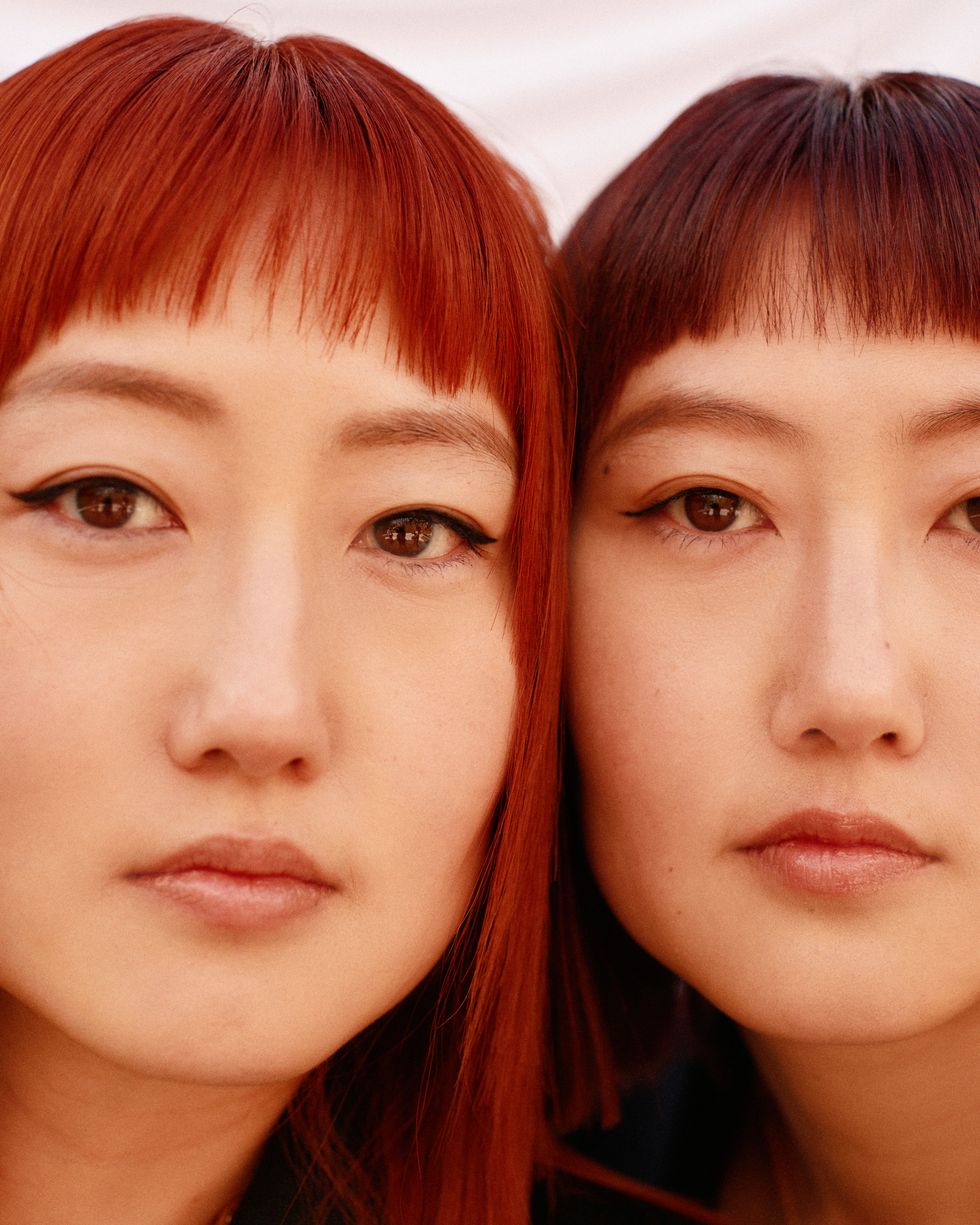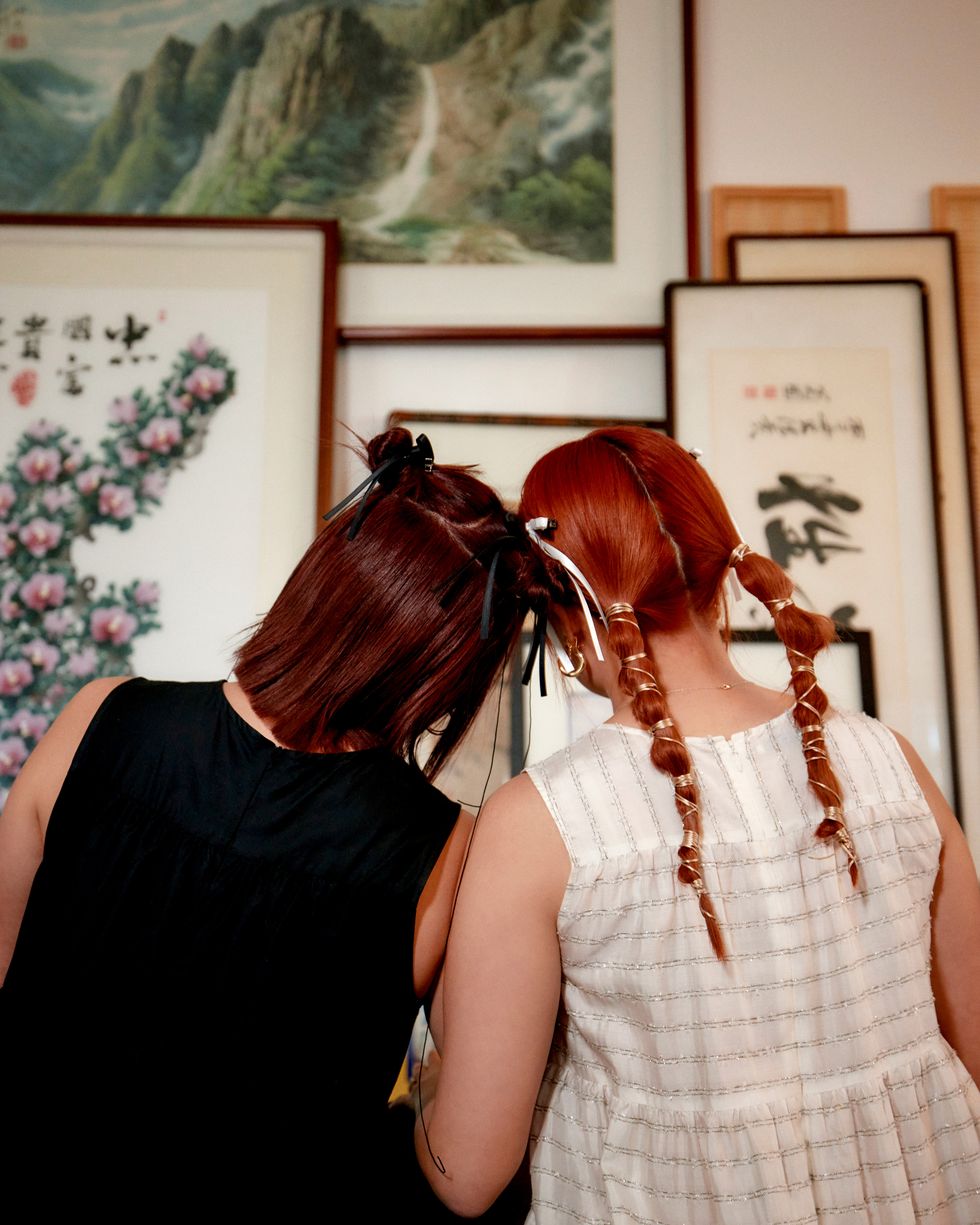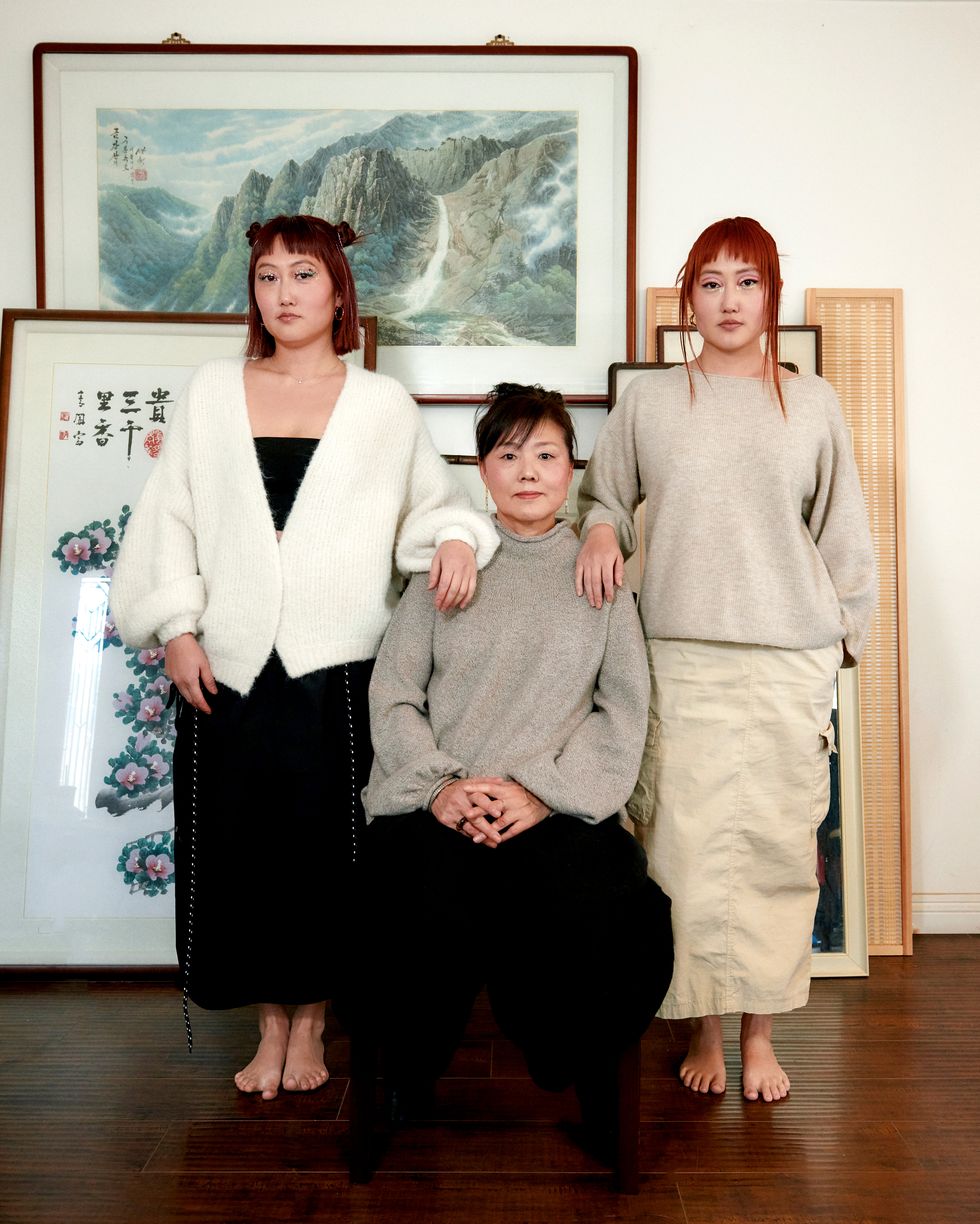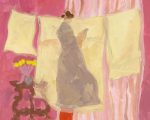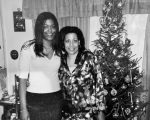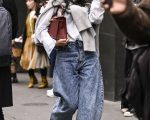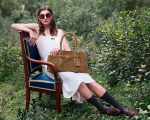The original post is located at www.elle.com
Growing up in the 1990s in the Jura region of eastern France, Laura Herbst knew by elementary school that she loved fashion, but she didn’t know where her passion came from. There was almost no social media back then, and she had no knowledge of clothing trends in the vast world outside her town. Her French village was known for its vineyards, lush rolling hills, Montbéliarde cows, and locally made cheese. There were no chic boutiques, not even an H&M. Her mom took her shopping at a cheap local clothing outlet. The plain outfits bored her.
Born in 1988, Laura was adopted as a toddler from South Korea. Her parents also adopted another child from South Korea, Laura’s nonbiological sister, who is five years older. “My older sister and I are Asian, and everybody was white. So it’s not that it was hidden,” Laura says of the adoptions. Their father was a carpenter, their mother a homemaker. Laura always knew she had been born a twin. Her parents never kept that part of her adoption story a secret, and they kept a file of adoption papers in the living room. “We were always able to open it,” Laura says, “and we had a couple of pictures.” She and her twin had been separated when they were infants. Laura and her adoptive parents did not know where her twin had ended up, and they didn’t try to find out. Laura liked the idea of having a twin, but didn’t know where to start. “Back then, we didn’t really have internet. I didn’t think I would be able to find her,” she says.
Instead, fashion preoccupied Laura’s thoughts. Each weekend, when the Sunday newspaper arrived at her house, Laura would pull out the thin fashion insert and trace the models and their clothing. Her mom bought her a secondhand sewing machine, and she used it to make a handbag out of a pair of jeans. When the machine broke down, Laura sketched manga characters and their outfits. She bought copies of Jalouse, a French fashion magazine. Her adoptive mom supported her design ambitions, even though no one else in their family had such aspirations. She always told her daughter she was a unique and creative soul, living on the edge. Her style influences certainly had not come from anyone in Jura.
Laura also loved art class, and whizzed through other subjects, graduating from high school a year early. She longed to attend fashion school, but her mom thought she was too young to live in a big city by herself. She ended up at a traditional college campus, which she hated. After six months, she finally convinced her mom to let her relocate to Lyon, two hours south, where she enrolled in École de Condé, one of the largest design schools in France.
On her first day, an instructor asked the students to go outside and sketch a river. Laura remembers thinking to herself, “I can’t believe I finally am where I’m supposed to be.” She dyed her black hair blonde, and wore glasses with no lenses. She leafed through her roommate’s copies of French ELLE.
Midway through her first year at design school, in 2007, her family told her they were planning a spring break trip to South Korea. By now, Laura was 19. She had never been back to her birth country or contacted the agency that had arranged her adoption. But her older sister had connected with a group of adoptees in France called Racines Coréennes, or “Korean Roots,” and she planned to search for information about her biological family while they were there.
During the period when the Herbst sisters were born, intercountry adoption from South Korea was at its peak. In 1985, more than 8,800 South Korean adoptees were placed in other countries, principally in the United States and western Europe. There are now over 200,000 Korean adoptees worldwide. In the 1990s, many began forming support communities, like the one Laura’s sister found.
Laura had always felt content with her life in France. She told herself she had come from a loving home, with a simple, country life. When she agreed to go on the 2007 trip with her family, she had no plans to search for her birth family. But when she arrived in Korea, the reality of the trip washed over her. “I’m so close,” she thought. “Maybe I can find my twin sister.”
She and her family met with a representative from the adoption agency. Her older sister’s file, it turned out, was empty. There was no trail to follow to her birth parents, or anyone else. She was devastated.
But then the woman next turned to Laura and gave her an unexpected piece of information: The agency had a contact phone number for one of her biological aunts, who lived locally. “If you want, we can call her,” she said. Laura said yes.
An hour later, the aunt, a glamorous dancer who had her own ballet studio in South Korea, arrived at the agency in tears. She brought her own daughter with her, who was three months older than Laura, and explained: “Your mom lives in Los Angeles. She’s a fashion designer. She lives w ith your twin sister, who is in art school.”
A fashion designer? Art school? Laura thought, “Oh my God.”
Laura’s aunt showed her a photo of her twin. “I was just so shocked,” she says. “I kept looking at it, because it was like me, but somebody else.” Then her aunt called Laura’s birth mom.
Laura’s twin, Mari Lee, was raised by her biological mother, Amy Lee. Growing up, Mari never knew her biological father, and she was also never told she had been born a twin.
Mari grew up in the bustling cities of Pusan and Seoul with her mom, who worked in costume design and the wholesale fashion industry, buying and designing items and selling them to distributors. Amy owned a retail clothing store in Pusan and a wholesale store in Seoul. Mari remembers gorgeous window displays in the store and her mom’s designs: floral prints and Korean motifs made with natural dyes on handmade cotton. Amy collected back issues of American Vogue and kept a shelf full of vintage fashion magazines from the 1920s to 1950s, which Mari loved flipping through. Her mom worked long hours, from morning to midnight. “She wasn’t able to take care of me,” Mari recalls. “So I was always living with my aunt and other people.” In 1995, when Mari was seven, Amy decided to move with her to Los Angeles, where she had a friend and hoped to find a new job. She had dreams of working in avant-garde high fashion.
It was difficult in America at first. Mari had to learn English. “I remember having trouble in class,” she says. “I went to five or six different elementary schools. We moved a lot.” They lived in Silver Lake, then Koreatown, before settling in La Crescenta. Along the way, her mother remarried and bought a home, and Mari became a sibling to her new stepdad’s two children. Over time, Mari adjusted to life in L.A., steadily growing her circle of friends. As a teenager, she loved going to Little Tokyo and sifting through the Japanese and Korean fashion magazines. She spent hours hunting through bins in thrift shops, finding red cowboy boots for $2 and shiny leather pants that she wore to school.
Two of her best friends were identical twin girls, and Mari remembers hanging out with them and admiring their twinship, while also feeling like a third wheel. She also befriended a pair of identical twin boys. Her mom joked that she kept bringing home twin friends. Mari didn’t yet understand the irony. She also loved a fashion blog about Mary-Kate and Ashley Olsen—this was during their big sunglasses and Balenciaga bag phase—and watched the Lindsay Lohan version of The Parent Trap, about 11-year-old identical twin sisters separated at birth, over and over. She used to beg her mom to watch the movie with her. Sometimes, Mari would say she wanted to be a twin. Her mom would change the subject. “I thought that it would be cool to have a twin,” Mari recalls. “I never thought, ‘Oh, there is a twin out there.’ ” Mari assumed it must be normal for everyone to wonder whether they had a twin, or how life would be if they did.
Once, when she was a little girl, Mari remembers finding a photo of herself as a baby, next to two other infants. She knew one of the babies was her cousin, but who was the other?
After high school, in 2007, Mari enrolled in ArtCenter College of Design in Pasadena to study illustration. She remembers it was finals week of her first year when she received a call from her mother, telling her to come home right away. Mari thought to herself, “She must have found out I’ve been smoking cigarettes.”
She expected to be scolded. Instead, her mom looked at her and said, “Don’t ask me questions, don’t say anything. Let me just tell you the story.”
Mari listened as her mom began to explain the story of her birth. At the time of her pregnancy, Amy said, her sister was also pregnant. But Mari’s aunt had been pregnant for three months longer than Amy, yet Amy’s belly was much larger. Mari sat quietly, wondering where the story was going.
Ultrasounds were not common in South Korea back then, and Amy did not know until the third trimester that she was pregnant with twins. A doctor heard two heartbeats. Mari was stunned. “You have a twin sister,” Amy told her daughter. “She is waiting for us in South Korea right now. And we’re going to get a red-eye flight tonight.”
Amy Lee, whose Korean name is Aeran, came from a family of creatives in the postwar era of the 1960s, when choosing an artistic career in South Korea was not encouraged. Still, her siblings would grow up to be dancers, designers, and performers. Amy remembers how much she enjoyed sewing class in middle school, earning perfect grades for learning to stitch traditional Korean garments by hand.
Soon, she began designing clothes that broke fashion molds in South Korea. Plain, neutral colors were the norm, but Amy crafted harem pants, flowery blouses, and fluorescent dresses. She worked in wholesale, but her fashion career was starting to take off when her mom got ill from severe asthma. Amy took care of her mom for the last decade of her life, putting her dreams of attending fashion design school abroad on hold. Her mom died in 1986, and Amy married that same year; the following year, she got pregnant. The surprise twin pregnancy nearly killed her, she says. She was in labor for 17 hours. One baby was breech and had to be rotated inside of her uterus. The twins were born on January 19, 1988, seven minutes apart. Amy was in a wheelchair for over a week. She named them Yaeryn and Chaeryn, after characters she read about once in a novel.
Life at home was overwhelming. Her marriage wasn’t working out, and she wasn’t getting the help she needed. Chaeryn was a calm, easy baby. But Yaeryn had constipation, skin irritations, and fevers. She was always crying and needing constant comfort from her mom.
Amy knew she couldn’t care for both babies on her own. And she was unaware of any social services that would help her keep the children together. It was a time when she was still running her clothing shop and trying to care for Yaeryn, while facing a potential future of being a stigmatized single mom without any support. So when a family member suggested adoption, she agreed, although it was a difficult, wrenching decision.
In the aftermath of the Korean War (fighting ended in 1953), the earliest adoptions generally involved mixed-race children born to South Korean mothers and non-Korean fathers—American or United Nations soldiers who had been stationed in the country. Many Westerners viewed adoptions as patriotic and pious acts, “rescuing” children from war-torn or impoverished countries, and perhaps assuaging their own guilt about their nation’s involvement in the conflict. Single mothers in South Korea also faced intense discrimination. Driven by Western demand, adoption became a multimillion- dollar business for Korean agencies. Intercountry adoption would continue at a swift pace through the 1980s.
Before she and Yaeryn left South Korea for Los Angeles in 1995, Amy visited the adoption agency and asked if she could have contact with Yaeryn’s twin. She knew Chaeryn had been adopted by a family in France. But the agency informed her it was a closed adoption, and she could not reach out to her yet. The agency advised her to wait to reconnect when Chaeryn became an adult and could consent to a reunion herself. Amy told herself she would try again, when the twins turned 19.
In Los Angeles, Amy found herself working in wholesale again, to her disappointment. She eventually also worked as a distributor and buyer for Forever 21, as the company tried to expand to South Korea and other countries. She enrolled at California Design College, graduating in 2000. But then she got pregnant with a son, and she put her fashion design aspirations on hold once again.
Amy says she did not tell Yaeryn, now called Mari in the U.S., about her twin because she did not want to upset her. She would tell her the story of her sister, she thought, after she found her. But before she could do so herself, Chaeryn found them.
“Someone is here for you,” came the call from the front desk. Laura was staying with her family at the Doulos Hotel in Seoul, a day after meeting her dancer aunt. She got into an elevator and headed to the lobby. When the doors opened, she got out. Laura took one look at the 19-year-old standing before her and had to take a step back. Her twin took a step back, too. “It was like a mirror,” Laura recalls.
Laura had bleached blonde hair. Mari had black hair. Mari remembered that on the plane ride her mom had complained that she was wearing dirty Converse sneakers to meet her sister. But she looked at Laura’s shoes—also dirty Converse sneakers. And both had on black entwined rubber bracelets, the kind you might buy at Hot Topic. “When we met, we were wearing the same thing, without planning,” Mari says. “We just kept staring at each other.” Everyone bawled, their faces soon puffy from tears. Amy kept speaking to Laura in English, though Laura spoke French. “I’m sorry,” she cried. “I’m sorry for abandoning you.”
“Don’t be sorry,” Laura tried to tell her birth mother. “I am so happy with my life.”
It has now been 16 years since their reunion, and Laura and Mari are as close today as twins who grew up together might be. Laura now lives in Bons-en-Chablais, near Geneva, while Mari still lives in L.A., now in Chinatown. But they talk every week and see each other several times a year.
After their initial meeting, and as Laura’s English improved, they grew closer, in part, because of their shared devotion to fashion. They sent each other links to fashion blogs.
Both sisters pursued careers in the fashion industry after college. Laura worked for Phoebe Philo at Céline, as a designer creating garments through sketches and 3D mock-ups. She later took a job as a collection director at MM6 Maison Margiela, a French luxury fashion house, where she had previously worked as a senior designer. Mari was the head of design at CO, a Los Angeles–based womenswear brand where she’d worked for over a decade, until leaving at the end of 2022.
They also both married and became mothers. Laura welcomed a baby girl in March 2022, and she is currently pregnant, due in February 2024. Mari gave birth in January 2023 to a boy who is about nine months younger than Laura’s daughter. Now they share tips about baby gear and clothing.
Laura’s adoptive mom died of cancer in 2009. “We always talk about her,” Laura says. “I think about her all the time.” But Laura has also built a relationship with her birth mother over the years. Amy has traveled to France to help Laura with child care, and she will do so again when the new baby comes.
Recently, Laura and Mari achieved a new milestone in their careers and sisterhood: They spent three years designing a fashion line together at CO Collections, coming up with concepts, choosing fabrics and colors, and styling lookbooks. “It was my dream to work with my sister,” Laura says, adding that they hope it will be the first of many collaborations. Amy says her daughters have already achieved the high-fashion dreams she never had a chance to reach herself.
For decades, researchers have studied twins to better understand nature versus nurture. Identical twins at conception share 100 percent of the same genes. Fraternal twins, on average, share 50 percent of the same genes, like biological siblings who are not twins. Scientists have studied twins separated at birth to try to understand how much genes shape who we are, in comparison to our environments. Mari and Laura have not yet been DNA-tested, but believe they are identical.
Today’s twin researchers also understand that a person’s interests, personality traits, and habits are a result of both genes and environment, interacting with each another in a mysterious, intricate kind of choreography.
But for Amy, the story of her twin daughters and their shared love of fashion, so reflective of her own, feels like their fates have been shaped by forces beyond environment alone. She thinks of this especially when it comes to Laura, who grew up with no fashion influences or surroundings, yet found her way into the field anyway.
“It is,” Amy says, “in the blood.”
